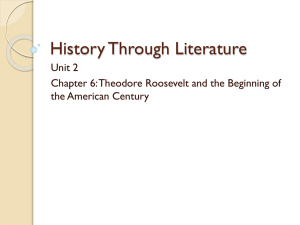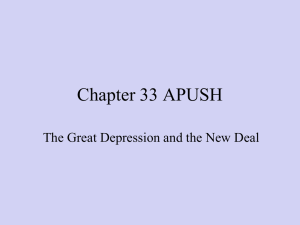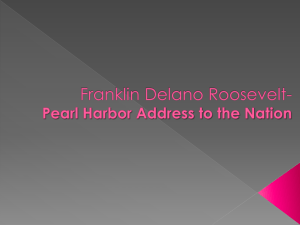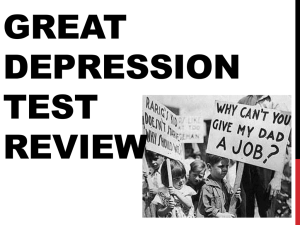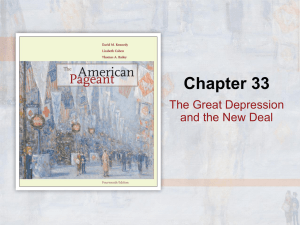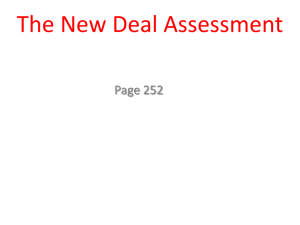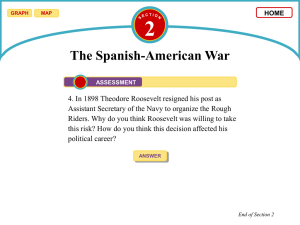SSUSH18_New Deal to Eleanor
advertisement
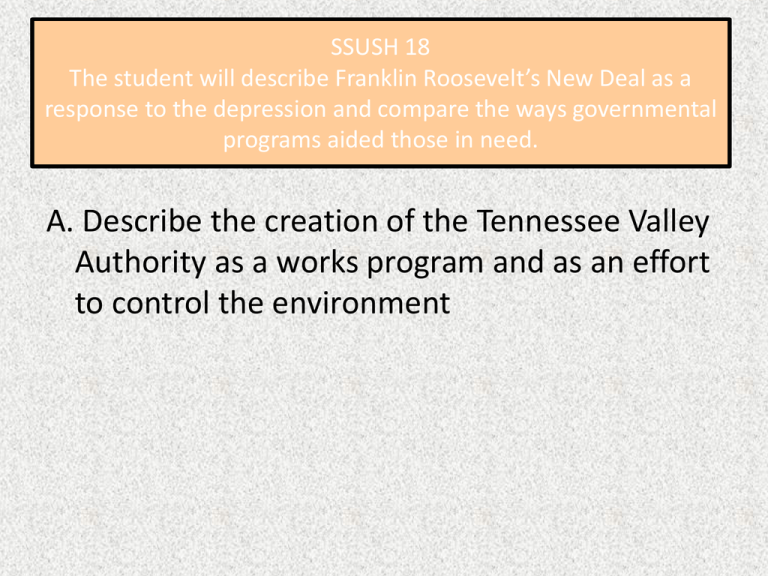
SSUSH 18 The student will describe Franklin Roosevelt’s New Deal as a response to the depression and compare the ways governmental programs aided those in need. A. Describe the creation of the Tennessee Valley Authority as a works program and as an effort to control the environment Election of 1932 Franklin Delano Roosevelt: Democratic nominee Progressive leader Gov. of New York Emphasis on relief programs The New Deal • FDR’s plan for ending the Depression • Focused on 3 R’s: - Relief of citizens problems - Recovery of economy - Reform society The Programs • Known as alphabet soup • Goal: address Three R’s • FDR successful beginning programs in 1st 100 days Emergency Banking Act establishes “Federal Deposit Insurance Corporation” TVA: Tennessee Valley Administration CCC: Civilian Conservation Corps: Created jobs in road-building & conservation projects to reduce unemployment National Recovery Administration set prices and est. codes of fair practice for industries Public Works Administration: Provided $ to states to create jobs building schools and community buildings & reduce unemployment Civil Works Administration: created 4 million jobs in effort to reduce unemployment SSUSH 18 The student will describe Franklin Roosevelt’s New Deal as a response to the depression and compare the ways governmental programs aided those in need. B. Explain the Wagner Act and the rise of industrial unionism Wagner Act • The National Labor Relations Board of the Wagner Act of 1935 was created by Congress to protect workers' right to unionization. • Guarantees employees the right to self-organize, choose their own representatives, and bargain collectively • Encourages collective bargaining as a means of maintaining industrial peace. SSUSH 18 The student will describe Franklin Roosevelt’s New Deal as a response to the depression and compare the ways governmental programs aided those in need. C. Explain the passage of the Social Security Act as a part of the second New Deal Second New Deal • Surge in New Deal programs -- popular, yet, somewhat ineffective • 1934 midterm elections Democrats • Many of 1st New Deal programs ruled unconstitutional (b/c federal government deemed to have overstepped its authority) • Led to “court packing” bill: attempt by FDR to increase # of justices on SC 2nd New Deal Programs • Works Progress Administration -- Employment in public works; building airports, repairing roads -- spent $ 11 billion & employed 8 million workers • National Labor Relations Act - commonly called “Wagner Act” - Recognized Labor right to organize & bargain Works Progress Administration Social Security Act: 1935 • 3 parts: 1) old-age insurance for retirees & spouses 2) unemployment compensation 3) aid to families with children & the disabled Funded by workers and employers, and federal funds made available to states The Social Security Question? • Social Security WILL eventually run out! • Baby-boomers retire! Causes more retirees than workers • Should retirement become privatized? SSUSH 18 The student will describe Franklin Roosevelt’s New Deal as a response to the depression and compare the ways governmental programs aided those in need. D. Identify Eleanor Roosevelt as a symbol of social progress and women’s activism Eleanor Roosevelt • Progressive reformer • Advocate for women’s and minority rights • Child welfare and housing reform SSUSH 18 The student will describe Franklin Roosevelt’s New Deal as a response to the depression and compare the ways governmental programs aided those in need. E. Identify the political challenges to Roosevelt’s domestic and international leadership; include the role of Huey Long, the “court packing bill,” and the Neutrality Act Examples of Challenges to FDR • Political challenges to Roosevelt’s domestic and international leadership • Role of Sen. Huey Long: LA: early FDR supporter turned critic -- wanted presidency; proposed national social program called “Share-Our-Wealth”; “Every man a king” -- assassinated in 1935 • The “court packing bill” • Neutrality Act: outlawed arms sales or loans to nations at war; FDR criticized when US sent arms to China durin Japanese aggression; “ISOLATIONISTS” PROTESTED



